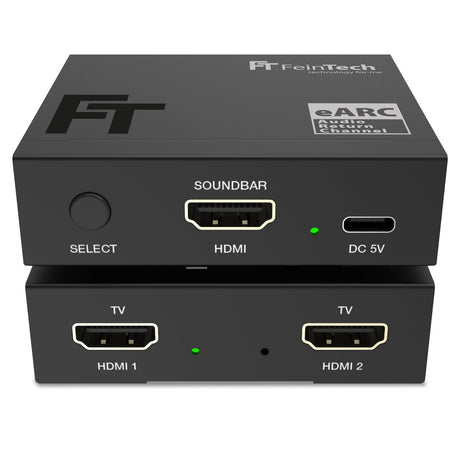The audio return channel is used to connect a soundbar or AV receiver to the HDMI input of a television. To do this, the television must support HDMI-ARC or HDMI-eARC (enhanced Audio Return Channel, which also passes through higher audio formats) on this port. Only one of the HDMI ports on the television can do this; the others work as normal signal inputs.
The television outputs sound via this HDMI input with ARC - in the opposite direction to the normal signal direction from player > television. The sound can come from the internal TV receiver, Smart TV apps or from a player on one of the other HDMI inputs.

So note: ARC sound comes from the HDMI input of a television and goes to the HDMI output of the AV receiver or soundbar. This audio signal is transmitted on different lines than the normal HDMI audio-video signal. HDMI-ARC is always a point-to-point connection. This has the following consequences:
- ARC audio cannot be distributed to 2 devices using an HDMI splitter
- The ARC signal cannot be amplified by a repeater or standard HDMI extender. So there is no advantage to using an active cable or fiber optic HDMI cable for ARC - because the ARC sound is transmitted in the opposite direction via other internal cable fibers. Most repeaters and fiber optic cables pass through the ARC/eARC channel without amplification. This is called passive transmission. However, this passive transmission is worse than with conventional HDMI cables because HDMI fiber optic cables are very thin, have 2 converters and therefore have higher losses in the audio return channel.
- Even a bi-directional switch cannot support ARC (bi-directional means that an HDMI switch can either switch 2 displays to one player or a player to one display)
The particularly “smart” soundbars from manufacturers such as Bose or Sonos take the user by the hand, making operation and installation very easy. However, these manufacturers only assume that the soundbar is operated directly on a television. For other scenarios - for example with a video projector or 2 displays - such a soundbar can only be used in a detour (e.g. with the VAX04101 ) and to a limited extent.
Signal distribution solutions
Unfortunately, there is no solution to use 2 sound systems on the television via HDMI-ARC simultaneously. Instead you could use the optical audio output of a television and split this signal to 2 sound systems. There are distributors for the optical audio signal / SPDIF Toslink available. This allows the audio formats Stereo, DTS and Dolby Digital to be transmitted. The volume control then has to be solved via the detours described here - or with an additional remote control.

If the audio-video signals do not come from the TV tuner or TV apps, but from an external player (e.g. Fire TV, Apple TV, Sky Q, Magenta TV), the signals can be distributed. An HDMI splitter or HDMI matrix switch is used for this. A soundbar and an AV receiver could then be supplied at the same time or alternately. But here too, the prerequisite is that the soundbar has at least 2 HDMI ports, namely a regular HDMI input in addition to the HDMI ARC port.
Outlook
We will soon be presenting solutions for switching ARC and eARC between 2 devices. The AX420 will make it possible, for example, for a TV and a video projector with ARC/eARC to share a soundbar. This switch therefore switches the input of the soundbar between 2 displays with ARC/eARC. No video signal is passed through, so it only makes sense to use it on a soundbar, not on an AV receiver. The AX420 will be delivered at the end of 2024.
The AX421, on the other hand, is a solution for operating 2 ARC/eARC sound systems on one TV. For example, you can switch between soundbar and AV receiver, or between soundbar and ARC headphone station. However, simultaneous audio output is not possible (and would not be in sync). The AX421 will be available from the beginning of 2025.






